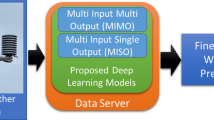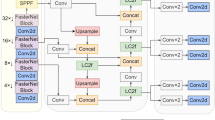Abstract
The accurate channel state information (CSI) is important to realize the high-reliability and high-efficiency transmission. So far, most of the conventional methods reconstruct CSI on non-RS position by the interpolation. However, high-speed mobility leads to the significant nonlinear channel variation and the performance of conventional methods is so poor that the reliability of transmission deteriorates a lot. In this paper, a novel real-time channel prediction algorithm based on convolutional neural network (CNN) is proposed, which uses the latest reference signal (RS) for online training and extracts the temporal features of channel, followed by prediction employing the optimal model. For high-speed moving scenario, the proposed algorithm is conducted in Orthogonal Frequency Division Multiplexing (OFDM) systems, e.g., long-term evolution (LTE) and fifth generation (5G) systems to track the fast time-varying and non-stationary channel via the real-time RS-based training algorithm, and obtains the accurate CSI without modification of the radio frame. Evaluated by experiments, the proposed algorithm outperforms conventional methods a lot, and more improvement could be achieved in the higher speed.
















Similar content being viewed by others
References
Zhou, Y., Pan, Z., Hu, J., Shi, J., & Mo, X. (2011). Broadband wireless communications on high speed trains. In 20th Annual Wireless and Optical Communications Conference (WOCC) (pp. 1-6).
Guan, K., Ai, B., Peng, B., et al. (2018). Towards Realistic High-Speed Train Channels at 5G Millimeter-Wave Band-Part II: Case Study for Paradigm Implementation. IEEE Transactions on Vehicular Technology, 67(10), 9129–9144.
Wang, C., Haider, F., Gao, X., et al. (2014). Cellular architecture and key technologies for 5G wireless communication networks. IEEE Communications Magazine, 52(2), 122–130.
Wang, S., Guan, K., He, D., et al. (2018). Doppler Shift and Coherence Time of 5G Vehicular Channels at 3.5 GHz. In 2018 IEEE International Symposium on Antennas and Propagation USNC/URSI National Radio Science Meeting (pp. 2005-2006).
Nguyen, Q., Luu, T., Pham, L., et al. (2016). Inter-Carrier Interference suppression combined with channel estimation for mobile OFDM system. In 2016 Second Asian Conference on Defence Technology (ACDT) (pp. 61-66).
Li, Y. (1999). Pilot-symbol-aided channel estimation for OFDM in wireless systems. IEEE Transactions on Vehicular Technology, 49(2), 1131–1135.
Hua, J., Zhao, X., Xu, Z., et al. (2007). An Adaptive Doppler Shift Estimator in Mobile Communication Systems. IEEE Antennas and Wireless Propagation Letters, 6(11), 117–121.
Lv, C., Lin, J., Yang, Z., et al. (2019). Channel prediction for millimeter wave MIMO-OFDM communications in rapidly time-varying frequency-selective fading channels. IEEE Access, 7, 15183–15195.
Fan, D., Zhong, Z., Wang, G., et al. (2015). Doppler shift estimation for high-speed railway wireless communication systems with large-scale linear antennas. In 2015 International Workshop on High Mobility Wireless Communications (HMWC) (pp. 96-100).
Liao, J. (2016). Analytical solution of DFT interpolated frequency estimator for Hanning windowed signal. In 2016 International Symposium on Communications & Information Technologies (pp. 177-180).
Liao, Y., Sun, G., Shen, X., et al. (2018). BEM-Based Channel Estimation and Interpolation Methods for Doubly-Selective OFDM Channel. In 2018 IEEE International Conference on Smart Internet of Things (SmartIoT) (pp. 70-75).
Khanshan, A., & Amindavar, H. (2007). Performance evaluation of two-dimensional interpolations on OFDM channel estimation. In 2007 Australasian Telecommunication Networks and Applications Conference (pp. 460-464).
Shi, L., Guo, B., & Zhao, L. (2009). Block-type pilot channel estimation for OFDM systems under frequency selective fading channels. In 2009 IET International Communication Conference on Wireless Mobile and Computing (pp. 21–24).
Zhang Z., Yao D., Xiong L., et al. (2020). A Convolutional Neural Network Decoder for Convolutional Codes. In 14th International ICST Conference on Communications and Networking in China (CHINACOM) (pp. 113-125).
Wang, Y., Liu, M., Yang, J., et al. (2019). Data-driven deep learning for automatic modulation recognition in cognitive radios. IEEE Transactions on Vehicular Technology, 68(4), 4074–4077.
Do, Q., & Koo, I. (2019). Actor-critic deep learning for efficient user association and bandwidth allocation in dense mobile networks with green base stations. Wireless Networks, 25, 5057–5068.
Huang, H., Xia, W., Xiong, J., et al. (2018). Unsupervised learning-based fast beamforming design for downlink MIMO. IEEE Access, 7, 7599–7605.
Ahmed Ouameur, M., Le, A. D. T., & Massicotte, D. (2020). Model-aided distributed shallow learning for OFDM receiver in IEEE 802.11 channel model. Wireless Networks, 26, 5427–5436.
Madhubabu, D., & Thakre, A. (2019). Long-Short term Memory based Channel Prediction for SISO System. In 2019 International Conference on Communication and Electronics Systems (ICCES) (pp. 1-5).
Wang, T., Wen, C., Jin, S., et al. (2018). Deep Learning-based CSI Feedback Approach for Time-varying Massive MIMO Channels. IEEE Wireless Communications Letters, 8(2), 416–419.
Yang, Y., Gao, F., Ma, X., et al. (2019). Deep learning-based channel estimation for doubly selective fading channels. IEEE Access, 7, 36579–36589.
Jiang, W., & Schotten, H. (2019). Neural network-based fading channel prediction: a comprehensive overview. IEEE Access, 7, 118112–118124.
Shah, S., Sharma, M., & Rangan, S. (2020). LSTM-Based Multi-Link Prediction for mmWave and Sub-THz Wireless Systems. In 2020 IEEE International Conference on Communications (ICC) (pp. 1-6).
Luo, C., Ji, J., Wang, Q., et al. (2020). Channel state information prediction for 5G wireless communications: a deep learning approach. IEEE Transactions on Network Science and Engineering, 7(1), 227–236.
He, H., Jin, S., Wen, C., et al. (2019). Model-driven deep learning for physical layer communications. IEEE Wireless Communications, 26(5), 77–83.
Zhou, T., Tao, C., Salous, S., & Liu, L. (2018). Measurements and analysis of angular characteristics and spatial correlation for high-speed railway channels. IEEE Transactions on Intelligent Transportation Systems, 19(2), 357–367.
Kingma, D., & Ba, J. (2014). Adam: A Method for Stochastic Optimization. In 3rd International Conference on Learning Representations.
Zhang, W., Yao, D., & Yang, M. (2013). Implementation of LTE-R Transceiver and the Performance with WINNER D2a Channel Model. In 5th IEEE International Symposium on Microwave, Antenna, Propagation and EMC Technologies for Wireless Communications (pp. 704–708).
Kysti, P., et al. (2008). WINNER II Channel Models. IST-4-027756 WINNER II D1.1.2 V1.2.
Zhu, Y., Dong, X., & Lu, T. (2019). An adaptive and parameter-free recurrent neural structure for wireless channel prediction. In IEEE Transactions on Communications, 67(11), 8086–8096.
Hoang, V., & Jo, K. (2019). Practical Analysis on Running Speed for Efficient CNN Architecture Design. In 12th International Conference on Human System Interaction (HSI) (pp. 221-224).
Singh, P., & Namboodiri, V. (2020). SkipConv: Skip Convolution for Computationally Efficient Deep CNNs. In 2020 International Joint Conference on Neural Networks (IJCNN) (pp. 1-8).
Acknowledgements
This work was supported by Fundamental Research Funds for the Central Universities (2020JBZD005), the Key-Area Research and Development Program of Guangdong Province under Grant 2019B010157002, the Royal Society Newton Advanced Fellowship under Grant NA191006 the Open Research Fund from Shenzhen Research Institute of Big Data under Grant No.2019ORF01006 and NSFC under Grant 61725101 and Grant U1834210.
Author information
Authors and Affiliations
Corresponding author
Additional information
Publisher's Note
Springer Nature remains neutral with regard to jurisdictional claims in published maps and institutional affiliations.
Rights and permissions
About this article
Cite this article
Xiong, L., Zhang, Z. & Yao, D. A novel real-time channel prediction algorithm in high-speed scenario using convolutional neural network. Wireless Netw 28, 621–634 (2022). https://doi.org/10.1007/s11276-021-02849-y
Accepted:
Published:
Issue Date:
DOI: https://doi.org/10.1007/s11276-021-02849-y




